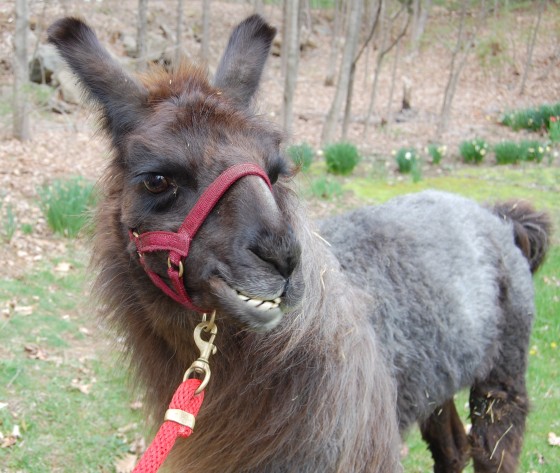So this post has been a long time coming and it’s also a dream come true. I’m really going to let my freak flag fly here and let you in on a not very well kept secret: I love llamas. I mean, seriously, LOVE llamas. It borders on an obsession.
It all started when I was a small child. Sesame Street had segment that featured a little girl leading her pet llama through the streets of New York. They were heading to the dentist. Its soundtrack was an up-beat song, “Me and My Llama.” I desperately wanted to lead my own llama through the streets of Philadelphia, and take him or her to the dentist, to the vet and maybe even a friend’s birthday party. I imagined it would make me the coolest girl on the block, with the coolest companion. I asked for a llama every Christmas for many years, yet Santa never managed to fit one in his sleigh. Years later, my mother confessed that she looked into what it would take to care for a pet llama, but alas, it was more than our backyard, or her patience, could support.
So when I got in the car on Sunday to drive out to Granby, MA to Pinetum Farm where Dave and Karen Seiffert own and run a llama farm, my excitement was palpable. I have certainly seen llamas before, at petting zoos, farms, etc. but I was overjoyed that I was going to spend some quality, one-on-one time with my favorite animal. Dave and Karen have owned llamas for about 15 years. They thought caring for llamas, and using their fiber for spinning and weaving would be a great way to spend their retirement (note to self). Since then they have become pseudo-llama celebrities appearing in the Boston Globe, the New York Post and event The Rachel Ray show.
The appeal was instant. “We fell in love with them, just like you,” Dave told me (I found my people!). Karen spoke about how peaceful llamas are, and how they are wonderful companions. “And they have eyelashes any woman would kill for,” she rightfully observed. Dave and Karen lead groups on hikes with the llamas on their 150-acre property. They also shear them and sell items that Karen makes out of their fiber in a small gift shop.
When we walked into the barn I started to giggle uncontrollably, and I think I said “This is so exciting” half a dozen times. While my reaction was not as much of a meltdown as when Kristen Bell met her favorite animal (a must-watch if you’ve never seen it), I could empathize with her near breakdown-producing excitement.
I feel llamas get a bad rap because they occasionally spit. But as Dave and Karen told me, that is really just a defense mechanism. Llamas don’t like to be touched on their faces, so image how you would feel if a dozen elementary school kids approached you at a petting zoo, screaming and wanting to tug on your ears. I’d spit too. Because I wanted desperately for the llamas to like me I was a little nervous about touching their faces. Although I totally wanted to kiss their noses, I refrained and stuck to patting the soft down on their necks that hides under their so-called “guard hair” which is much coarser.
We hung out in the barn for a while where the females (and neutered males) are separated from the male, Honey Crisp (female llamas can get pregnant any time so they have to be kept apart). Then we put a harness on one of the Seiffert’s sweetest llamas, Stone. Just like the little girl from Sesame Street (sort of) I grabbed Stone’s leash and we walked up a hill to a knoll where he happily nibbled on grass, and I happily pet him as I tried to absorb all the llama knowledge that Dave and Karen were giving me. They were right, Stone was so sweet. And I think he really liked me too.
I was surprised to hear that Llamas don’t take that much attention. Dave spends about an hour in the morning and night feeding and taking care of them. They are sheared about once every-other year, although that can be more often depending on if a llama is pregnant (they can get over heated) or how fast their hair grows. Dave and Karen hike with them, but they are also content to just hang out with each other in the barn.
I’m not saying my next passion in life is to own a dozen llamas (That would be bad, right? Talk me out of it…), but it was so fun to spend the afternoon with these awesome animals (not to mention their amazing owners) and to see that they really lived up to all my hype.
If only my apartment building allowed pets…
Many thanks to Dave and Karen Seiffert for allowing me to spend the afternoon with them and their llamas. If you love llamas as much as I do (although I’m not sure that’s possible), or are looking for a fun activity with kids check out their llama hikes! I was not compensated for this post in any way.
















